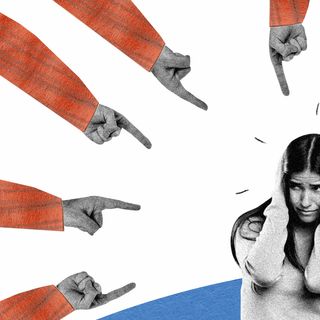
Can Sex Robots Improve Quality of Life for Elderly, Disabled People Who Don’t Have Human Companionship?
Rethinking sex robots as intelligent, respected companions who are able to engage in sexual intimacy could improve quality of life for people who lack social support.

This is the first article in a two-part series about how humanoid robots may change how human society understands sex and sexuality.
She’s five foot one, has 32F breasts, action sensors, a bluetooth speaker and built-in heat sensors. She can moan, thrust, seduce, and learn to react to basic word commands. Her ideal customer is a straight man who says things like, “Now all you need to do is to make it cook and clean and woman will be obsolete lol” or “I prefer them when they don’t talk.” (These are real comments under an ad for sex robots.)
The robotic sex doll is popularly joked of as a fetish object for lonely rejects who almost always happen to be heterosexual men. But some believe the potential for these dolls extends far beyond being mere masturbatory aids. “Unlike other objects used to enhance sexual activity, sex robots simulate being with another human being and involve forming a human-robot relationship,” writes Nancy S. Jecker, PhD, in the Journal of Medical Ethics. Jecker, a bioethics professor at the University of Washington School of Medicine in the U.S., believes that this human-robot relationship can be harnessed to create more holistic lives and provide dignity to individuals who do not have access to human companionship. This view is backed by researchers working in robotics innovation and medical fields who argue robots can aid individuals’ sexual, emotional, and educational needs.
Jecker mainly sees value in destigmatizing and creating access to sex robots for older people, people with disabilities, and especially elderly people with disabilities, in order to afford them a higher quality of life and the dignity of companionship. Societal attitudes towards the elderly, and disabled individuals of any age, are dismissive and othering, which colors perceptions of their sexual desire. Older people face ridicule because pop culture desexualizes them, especially post-menopausal women. Disabled individuals, according to disability scholar Tom Shakespeare, are either presented as “asexual — or else perverse and hypersexual.” In reality, older people and disabled people experience sexual desire and seek out sex much like anyone; the difference is, they often feel inhibited or judged when they do so, which can impair their ability and confidence as sexual beings.
In a more physiological sense too, older individuals may face challenges when it comes to sexual activity due to gradual changes in reproductive organs (less-firm erections, drier vaginas) and the advent of chronic illnesses that bring along pain and fatigue. These conditions can make it much harder for older individuals to satisfy their sexual needs without outside assistance. Disability takes many forms and often poses physical challenges to sexual intimacy as well. Humanoid, hyper-customizable sex robots are, therefore, an attractive possibility for helping such individuals fulfill their needs.
Related on The Swaddle:
The Tech Industry’s Sexism, Racism Is Making Artificial Intelligence Less Intelligent
However, in terms of this becoming reality, the current market might have a long way to go. One survey found 66% of individuals 55 years and older would never consider having sex with robots. This reluctance might stem from the way sex robots are currently marketed and the cultural stereotypes surrounding them.
“The current sex robot industry is focused almost exclusively on young, able-bodied, male clientele. What kind of message does that implicitly send to older people, especially older women and people with disabilities?” Jecker said in an email interview. To reposition access to sex robots as a positive, community-oriented means to add dignity to older, disabled individuals’ lives, Jecker stresses the need to reimagine both the design and the possibilities of sex robots.
From a utilitarian perspective, outlined in the research of Eduard Fosch-Villaronga and Adam Poulsen, a sex robot’s unique features make it useful for a lot more than just a means for masturbation. Some older and disabled individuals are frail, less agile, and have weaker bones and muscle mass. A robot’s ability to vibrate, massage, and even thrust makes it capable of doing much of the work required to attain sexual satisfaction, which can help a physically impaired person feel sexually satisfied.
But, what also matters is the sex robot’s ability to create an environment of comfort and intimacy, accomplished via their soft build, internal heating systems, and conversational ability. These characteristics, however, are marketed as a means to enhance the titillation of the young, cis-hetero male customer, rather than a means to reach a diverse market.
The dignity and companionship inherently possible in sex robots can only be realized and accessed if they are reframed as intelligent, non-objectified aides, rather than sexual receptacles.“…Part of what is sought through engaging in sex [with sex robots] is sexual relationships. Even though many people with disabilities can self-stimulate, self-stimulation alone cannot satisfy that desire,” Jecker says.
To reimagine the way sex robots are perceived begins with doing away with the ageist, ableist, and heterosexist biases that populate the industry. Some companies, like U.S.-based Realbotix and China-based DS Dolls have attempted to do so by creating the world’s first male sex robot Henry and first transgender sex robots respectively. Their aim is to create sex robots that encompass multiple gender orientations to help satisfy a variety of sexual preferences, representatives say. However, activists worry that these robots still carry certain features that can alienate the people it’s trying to include. For example, the transgender sex robots received backlash from the trans community due to the robots’ design, which involved detachable penises. The concern was that these robots will still continue to cater to men as part of the offensive ‘she-male’ fetish. Trans activist Christine Burns told The Sun, “this kind of exploitative fantasy creation simply reinforces the idea that trans women are sexual objects.” While the attempts to create diversity in sex robots show a commitment to diversity, designs that consider the real needs of particular communities could successfuly attact a more diverse audience. This in itself could reframe how people view sex robots and their capabilities.
Related on The Swaddle:
Tech Is Shaping a New Type of Sexuality
The human-robot relationship is not meant as a substitute for human relationships, but as a distinct entity of its own. In an interview with New York Magazine, Matt McMullen, the founder and CEO of Realbotix, says, “If people are connecting with other people through technology, and if those virtual connections create loneliness and isolation, why not use technology to create an alternative sort of relationship — a relationship with technology?” Jecker puts forth the idea that human beings tend to anthropomorphize non-sentient things like robots if things have names and back-stories, but “our relationships with robots will not be the same as human-human relationships; they will be something else.”
These possibilities have given way to a new generation of people whose sexuality and ideas of intimacy are shaped by second-wave technologies — Artificial Reality, virtual reality, and yes, sex robots — who call themselves digisexuals. This particular identity could evolve to find mainstream acceptance soon, according to ethicist Neil McArthur and sexologist Markie Twist. Several futurists make concurrent predictions: Ian Pearson predicts humans will utilize robots for companionship by as early as 2030. Ian Yeoman and Michelle Mars believe the world may have robotic brothels by 2050. Plus, artificial intelligence expert David Levy predicts that sex with robots will be almost routine by 2050.
Though these predictions hint at an exponential rise in sex robots’ presence in human lives, their future still revolves only around their sexual value. The actualization of sex robots’ full potential hinges on their normalization as a means of assistance rather than their popularity as sex objects. To achieve this, it is necessary to overcome moral bias and start viewing sex robots as a means to achieve human dignity. As Jecker says, “… My key concern is dignity, by which I mean supporting older people’s minimal capabilities, such as their ability to affiliate with others; express emotions; have bodily integrity; be healthy; exercise senses, imagination, and thought. These are some of the central things we can do and be as human beings. They mark the difference between being alive and having a life.”
Aditi Murti is a culture writer at The Swaddle. Previously, she worked as a freelance journalist focused on gender and cities. Find her on social media @aditimurti.
Related


India’s Teen Pregnancy Numbers Have Dropped Steadily for 20 Years: Report
